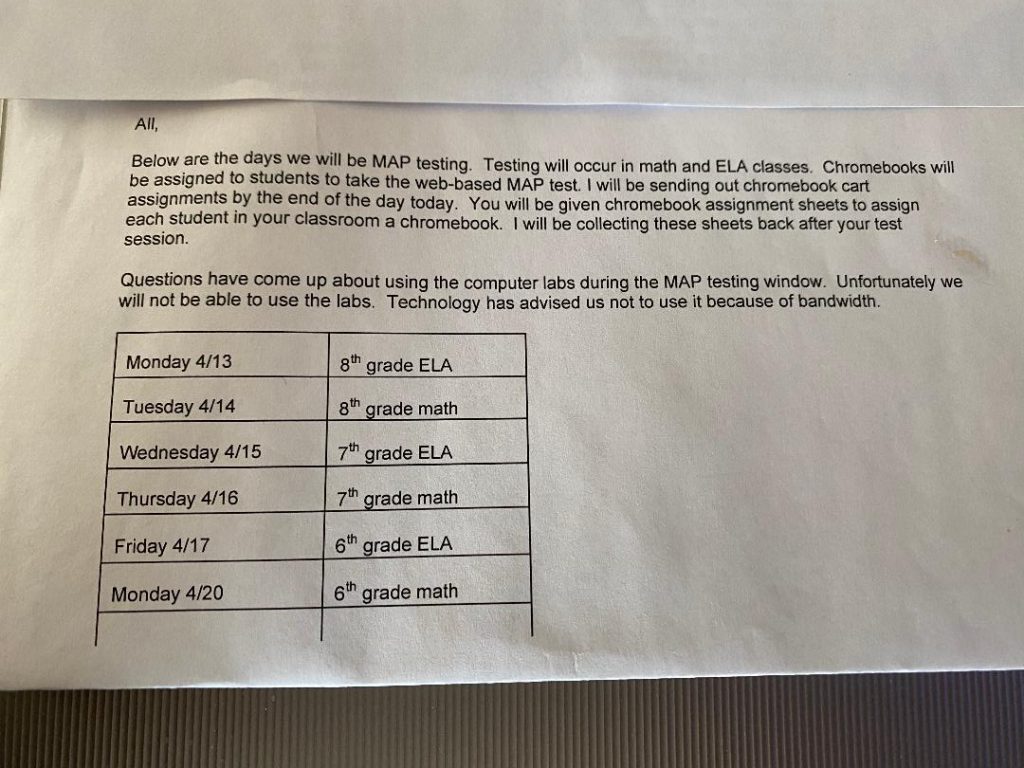I’d like to invent some hypothetical math that makes a simple point: The plan by the Illinois State Board of Education to triple the number of annual standardized assessments for students will most hurt the students who are already behind. I can prove this.
Parents, teachers say state plan to increase student testing in Illinois will hurt most vulnerable kids – Chicago Tribune
To start, I am going to invent two students. I will call them Fred and Barney.
Fred is a bit above grade level. In order to be ready for the next year, he requires 150 days of instruction. Yes, I just invented Fred, but there are many Freds in the system. These students tend to test decently.
Barney has fallen a few years behind grade level. To be ready for the next year — that is, to cover the past curriculum he somehow failed to master and then reach grade level — Barney requires 320 days of instruction with supplemental evening and week-end tutoring. Barney doesn’t test well, of course. That’s how we know he is significantly behind grade level. In some Chicago public schools, many members of the student body qualify as a Barney. *
In my above example, Barney needs 320 days to “catch up” to grade level. In real life, that number might be 290 or 510 days. An exact count would be impossible to determine. The concept “grade level” is in constant motion, as is Barney. Grade level can change radically with one sweep of the standards too. Many on-target students stumbled down the stairs toward the basement with the arrival of the Common Core standards and related tests.
A lot of factors are in play and my learning curve is not actually linear. Barney may learn at an average or even faster pace and may have fallen behind due to missing school and moving frequently. Barney may be a slow learner with undiagnosed dyslexia. But whatever the source of his lower achievement, he’s behind. He will require extra instruction to catch up, extra instruction that may not exist for him, especially since we now try to pack every minute of every school day with standards-based instruction.
Now let’s look at the math. I want to show how the three-test-more-testing plan discriminates against poor Barney. My last school year, I lost over 1/5th of the year to testing, but we will assume less loss here. Let’s say days lost to standardized testing and benchmark tests only total 16 days, an optimistic choice of values. When I left off, the actual instructional days in Chicago Public Schools totaled 170 days.
Fred’s fine. He can be fully ready for next year, with the caveat that he’ll have to make up a bit of summer learning loss.
170 total school days – 16 test days = 154 days of instruction available to Fred. That’s enough for Fred, who is already above grade level and a fairly quick study academically. He only needs around 150 to stay at grade level. He will be ready to tackle next year’s subject matter. In numbers, 154 – 150 = +4
Barney may also have 154 instructional days. Sometimes our Barneys go to summer school, but that school is not always mandatory or even available. Barney is already deficit spending where schools days are concerned. In numbers, 154 – 320 = -166. No summer school can begin to fill this gap, especially since summer school often only runs four or five hours a day for four to six weeks.
Let’s charitably assume that Barney receives mandatory summer school for five hours a day for five weeks. We’ll count those days as 3/4s of a regular school day. In math terms, 25 days times 0.75 = 18.75 regular school days. So let’s give Barney 18.75 days credit to get a less onerous estimate: -166 + 18.75 = -147.25. After summer school, Barney now only requires an additional 147.25 extra days ON TOP OF A REGULAR SCHOOL YEAR to catch up to grade level. If this were a word problem, I would ask students what mathematical process we might use to express “on top of,” expecting to hear, “You add the numbers, Ms. Turner. ”
Barney requires 170 + 147.25 = 317.25 days total to catch up to grade level. That’s a mountain to climb — and currently we make almost no provision for our Barney’s when they have fallen that far behind. Where will the time come from to add that missing learning on top of the full, packed curriculum already laid out for his age?
We stole 16 days of instruction from these two students with standardized tests. We stole nearly 10% of the school year. With additional benchmark, AP, ACT and other tests, we may be stealing considerably more. But who feels the loss from those 16 days more?
“It’s only another 3 days or six days or week and a half,” our leaders will offer as justification when the increased time required for added testing hits the radar. But here’s the thing: Fred’s not falling behind. He has a margin of power around his daily academic needs. He might be a little more prepared for college calculus if he had an extra month of instruction instead of new tests during high school. Because of those tests, he might end up going for extra tutoring to help him though his first college mathematics classes. But Fred will be ready to move on to tougher material after he graduates from high school. We stole a few of Fred’s cupcakes, but Fred still has enough cupcakes to keep himself from ever going hungry.
Barney, on the other hand, is starving. He has been for a long time. That’s what phrases like “three years behind grade level” mean. He’s so academically hungry that he’s hurting unless he has decided not to care, a common response that’s sometimes the only psychic self-defense available. Barney never had any cupcakes to spare. He needs every academic week he can get — and a number he will probably never see. Every lost week leaves him more confused, and the more confused he gets, probably the more demotivated he becomes.
There’s a macabre sort of irony here: We test and test to find out where our students stand.
We keep stealing their food in order to determine how malnourished they have become.
Barney needs more time learning mathematics in math class, not more time documenting how much mathematics he does not know so that government leaders can wring their hands in public, published despair about how poor Barney is in such awful shape. It honestly makes me think of Munchausen syndrome by proxy, the mental health problem in which a caregiver deliberately causes sickness in a child, elderly adult, or disabled person. Our Barneys are starving for learning time and are becoming hungrier all the time. Instead of feeding them, instead of teaching them, we give them weeks of extra tests and then trumpet their declining academic health.
Eduhonesty: Damn, this is crazy, and it never seems to stop. Yes, we need testing to gauge student progress, but not weeks and weeks of testing. We ought to be able to produce progress reports with one single robust benchmark test given for two days, three times a year, for a total six-day instructional loss.
We are focusing on America’s score numbers when what we ought to be focusing on is our students’ INSTRUCTIONAL TIME numbers. How much time do our students require to catch up? How can we increase the learning time they receive? We can’t improve Barney’s situation without giving him more time, yet somehow plans by government leaders and educational bureaucrats always steal time away from Barney and other struggling students instead. How hard is it to understand that testing directly steals instructional time — a commodity that the some kids can afford to lose, but others cannot?
I put numbers in this article to try to make that loss more real. This is the testing version of my last post: Them as Has Always Seems to Git More. The privileged kids in privileged districts get more — and they also lose less. Maybe both my boys lost 16 days, but the value of those days was much smaller for Fred, who did not need that instructional time to effectively stay caught up.
Meanwhile, like I said, poor Barney is starving while political leaders and educational bureaucrats keep aggressively raiding his dwindling and already inadequate supply of cupcakes.
*Incidentally, it’s extremely hard to get current information related to student academic progress right now in Illinois. The Illinois interactive state report card used to be a robust source of data. This year, however, the site blames COVID and simply does not provide many numbers. They may not have those numbers. A more sobering possibility: Perhaps those numbers came in so low that no one wants to put them up for public review.











